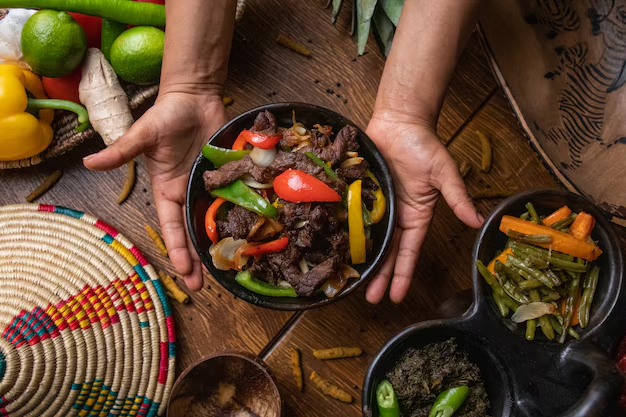Food is an essential part of every culture, and every region has its distinct flavors, ingredients, and culinary techniques that make its cuisine unique. Exploring global cuisines not only offers us a taste of the world’s diverse ingredients but also connects us to the traditions, history, and customs of different cultures. From spicy Indian curries to savory Italian pastas, every dish tells a story that is centuries old.
Indian Cuisine: Bold and Spicy
Indian cuisine is known for its intense and complex flavors. Spices such as cumin, coriander, turmeric, and garam masala are used in abundance to create aromatic and bold dishes. The regional variations are vast; from the rich butter chicken of the North to the spicy fish curry of the South, Indian food offers a delightful mix of flavors. The use of fresh herbs, yogurt, and rice complements the intricate spice blends that are the hallmark of Indian cooking. It’s a cuisine that reflects the diverse geography and cultures of India, making it one of the most loved and globally influential.
Italian Cuisine: Simple Yet Flavorful
Italian food is built on simplicity, with high-quality ingredients at its core. Olive oil, fresh herbs like basil and oregano, and tomatoes are often the base of many Italian dishes. The global love for Italian food has made dishes like pizza and pasta household staples. The concept of la dolce vita (the sweet life) is captured through rich desserts like tiramisu and cannoli. Italian cuisine emphasizes the importance of family, fresh ingredients, and the art of creating balanced and wholesome meals.
Mexican Cuisine: Vibrant and Hearty
Mexican food is rich in both flavor and tradition, with its use of corn, beans, chilies, and fresh ingredients. Dishes such as tacos, enchiladas, and guacamole have made Mexican cuisine a favorite worldwide. What makes Mexican food so appealing is its balance of flavors – from spicy to sour to sweet. It’s not just the ingredients that make Mexican cuisine special, but the cooking methods, such as slow-cooked meats and the use of masa (corn dough) for tortillas. The cuisine reflects Mexico’s long history, from indigenous traditions to Spanish influences.
Japanese Cuisine: Precision and Freshness
Japanese cuisine is known for its emphasis on freshness and presentation. Dishes like sushi, sashimi, and tempura rely on the highest quality ingredients and require meticulous preparation. The use of fresh fish, rice, and simple seasonings like soy sauce and miso create an elegant and balanced meal. Japanese food is more than just sustenance; it is an art form. Every dish is carefully crafted to highlight the natural flavors of the ingredients, and even the presentation is considered part of the dining experience.
Chinese Cuisine: A Symphony of Tastes
Chinese cuisine offers a wide array of tastes, from the sweetness of Cantonese cuisine to the fiery spiciness of Sichuan. Stir-fries, dumplings, and noodle dishes are staples, and they often combine salty, sweet, sour, and umami flavors in a single dish. Techniques like wok frying and steaming are used to preserve the delicate textures and enhance the flavors of ingredients. Chinese cuisine is also rooted in balance and harmony, not just in flavor but in nutrition and texture as well.
French Cuisine: Rich and Refined
French cuisine is often considered one of the finest in the world, known for its rich, complex flavors and meticulous techniques. Dishes such as coq au vin, escargot, and ratatouille showcase the depth of French cooking. France’s influence on the culinary world is profound, with its pastry arts, wine culture, and fine dining standards. French cuisine also emphasizes the use of seasonal ingredients, and each region of France has its specialty, from the seafood dishes of Provence to the hearty stews of Burgundy.
FAQs
1. What is the most popular global cuisine?
Italian cuisine is often regarded as the most popular globally, with pizza and pasta being beloved dishes.
2. Why is Indian food so spicy?
Indian cuisine uses a variety of spices to create layers of flavor, and spice is a key component of many regional dishes, adding depth and complexity.
3. What makes Japanese cuisine unique?
Japanese cuisine is known for its precision, freshness, and focus on the natural flavors of ingredients, as well as its aesthetic presentation.
4. What are the key ingredients in Mexican cooking?
Corn, beans, chilies, and fresh herbs are the primary ingredients in Mexican dishes, contributing to its vibrant and hearty flavors.
5. How does French cuisine influence global dining?
French culinary techniques and pastry arts have significantly impacted fine dining worldwide, influencing both professional chefs and home cooks.
6. What are some healthy global cuisines?
Japanese and Mediterranean cuisines are often considered healthy due to their emphasis on fresh fish, vegetables, and whole grains.
7. How do spices affect global cuisines?
Spices are used globally to enhance flavor, preserve food, and create a distinctive regional identity in cooking.
Conclusion
Exploring global cuisines offers a rich tapestry of flavors, textures, and cultural insights. Every dish tells a story, and every cuisine has its own unique heritage that reflects the values and history of its people. Whether it’s the bold spices of Indian cuisine, the fresh ingredients of Italian food, or the refined techniques of French cooking, each culinary tradition brings something special to the table. By appreciating these global dishes, we connect with the diverse cultures that have shaped our world.




